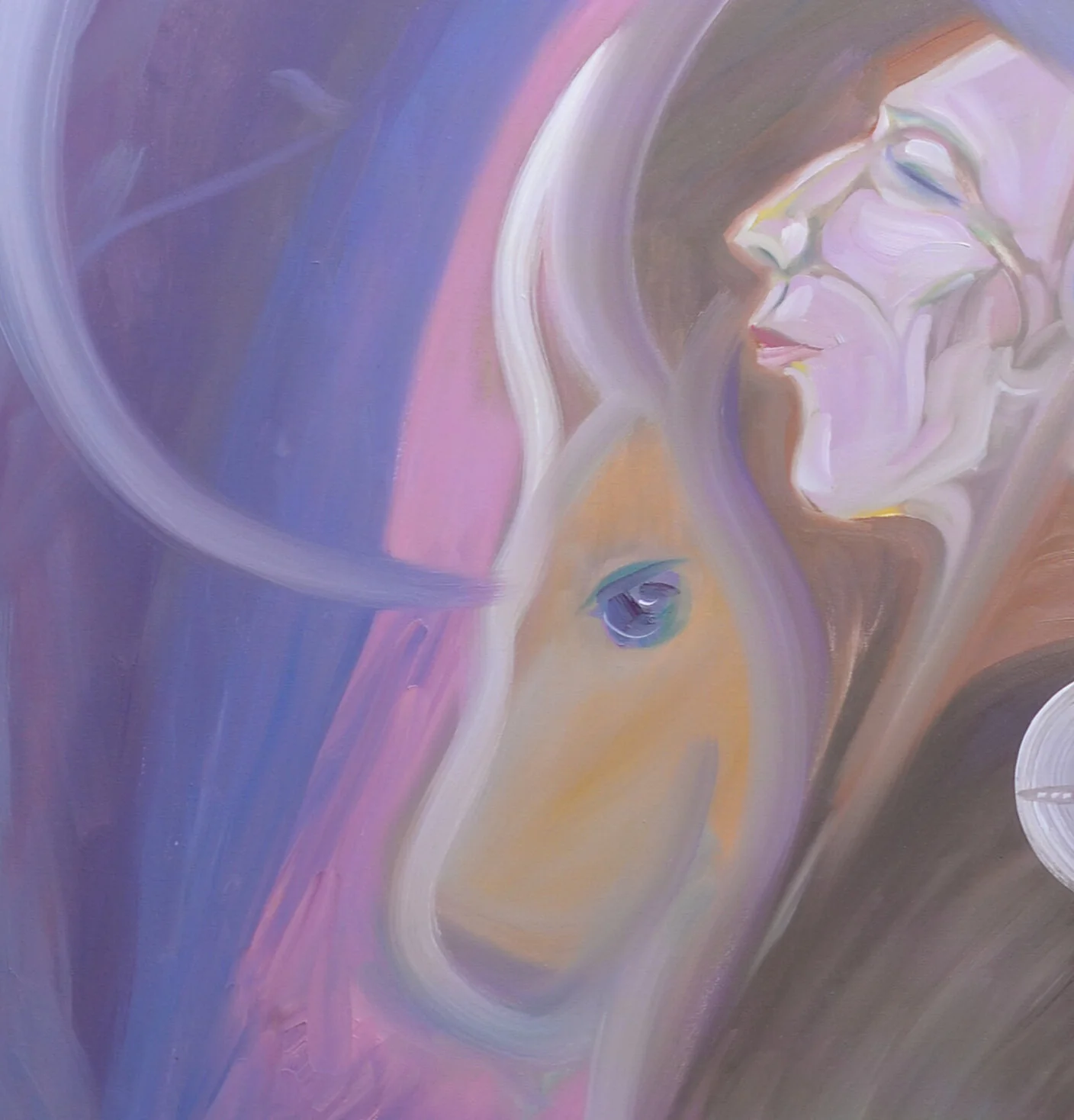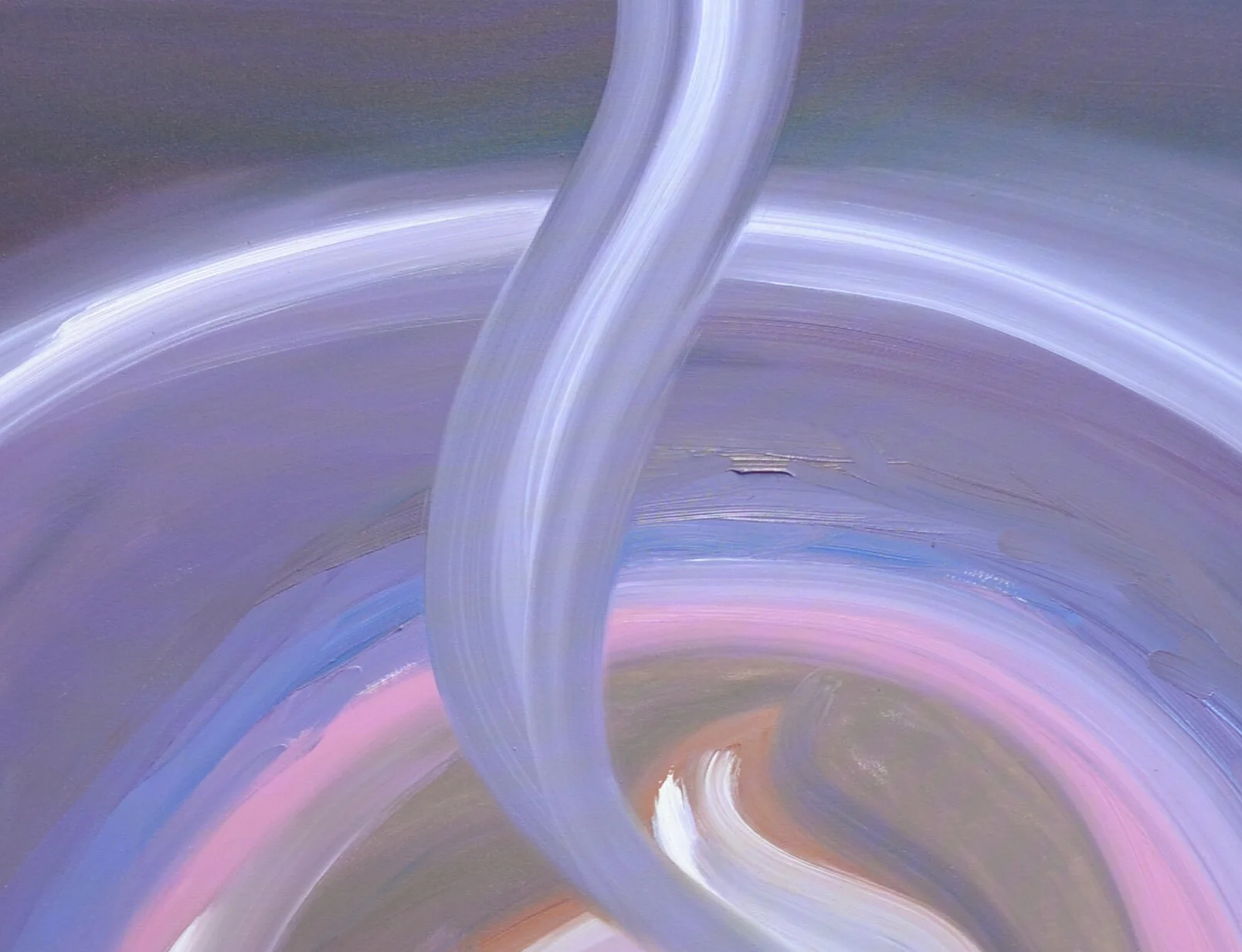ALEX JANVIER’S THE OLD ONE
Alex Janvier, THE OLD ONE, 2001, oil on canvas, 183 x 121 cm. Courtesy of private owner. Photo: Zyp Art Gallery.
Alex Janvier is one of Canada’s most celebrated artists. Significant honorifics include the Order of Canada (2007), the Alberta Order of Excellence (2010), and the Distinguished Artist Award from the Lieutenant Governor of Alberta (2017). Incredibly for such a recognized artist, many Canadians have not heard of him! Thankfully that is not the case of his works. Janvier’s artworks adorn many public spaces - if you visit Rogers Place to see the Edmonton Oilers you have walked upon Tsa Tsa Ke K’e (Iron Foot Place). Perhaps you have visited the Alberta Legislative Building and sat in the Chamber; there on your right and left you will see the only physical acknowledgement to the Indigenous Peoples of Alberta - Sunrise and Sunset. Or have you had a chance to visit the Canadian Museum of History in Gatineau? Well look up high and in the dome you will see his, and Canada’s greatest masterpiece, Morning Star - Gambeh Then’.So just who is Alex Janvier? Thankfully, just as prolific an artist he is, he has been equally open and generous with his story. His style is famously known for its abstract weaving of linear colours and he is said to be the first artist to link modernist abstract styles with Indigenous, specifically, Dene iconography. His art, much like his life is intimately linked with the turbulent relationship of the Government of Canada and the Indigenous People of this land. Here is some of his story.Identity Created, Identity Robbed
Alex Janvier (b.1935), of Denesųłįné and Saulteaux descent, was born in the Le Goff Reserve in an area called Good Cow Lake, of the Cold Lake First Nations, in Treaty 6 Territory. Janvier’s father Harry, was the last of the traditional chiefs, and as Janvier recalls he grew up in a humble, but loving family that lived off the land. The story of Janvier learning to paint at the residential school is well known, however, Janvier states that his real beginning was at Blue Berry Point, a place where families would gather every summer, where he entered the “Indian” life the proper way. (1)Like many Indigenous youths his age, in 1943 Janvier was thrown into the back of a cold truck and sent to a residential school - Blue Quills in St. Paul, Alberta, about 100km away from his home. Forced into a world they didn’t understand, taught by people who believed they were ‘sauvage’; Janvier and his peers experienced their culture being excised, while trying to survive an existence controlled by Catholic Oblate priests and Grey Nuns who imposed a severe regime of prayers, child labour, and learning from 6 a.m. to bedtime at 7:30 p.m. (2)Janvier remembers this period emotional, “they removed your identity, they remove your belief, they removed all your association with the Elders, they remove the love of your mother and father, they remove the love of your siblings, they remove all the tribal members”. Yet somehow within this prison, during the 3 hours a week dedicated to art, Janvier found his freedom - the art gave him strength and the means to survive, he says it saved his heart. (3) Janvier’s art was encouraged by the school’s principal Rev. Bernet Rolande. He had Janvier sent to Edmonton for four summers where he was tutored by Karl Altenberg, a student of the Bauhaus tradition and a Professor of Art at the University of Alberta. Janvier remembers Altenberg would open art books and have him study the pictures, and not the words. Janvier was a already a keen observer, having spent his early years watching the land he remembered fondly, so his analysis proved deep and insightful. Fondly remembering his time with Altenberg, Janvier says “He got me to see beyond being an Indian, beyond the reservation, beyond Canada,…There was a world out there that I could associate with, without being bogged down by any [Indian] agent or priest or whatever. For the first time, in my mind I was liberated.”(4)At only 15, Altenberg commissioned Janvier to create paintings for the Blue Quills chapel. One of the paintings, Our Lady of the Teepee (1950) was at first considered a sacrilegious image of the Virgin Mary in Dene motifs. However, once tempers calmed, the work was sent to Rome to participate in the International Vatican Exhibition – it won second place. And so establishes the ebb and flow of conflict and acceptance that shaped Janvier’s life and the reception of his work.The Indian Agent and Art School
After 10 years of residential school torture, Janvier was free. Yes, free from the residential school, but still under the control of the Canadian government in the form of the Indian Agent. At first Janvier had plans to become a priest, and was allowed to go to Manitoba. But after four months Janvier realized that his journey was with his art. Thus he applied and was accepted to prestigious art colleges in both the UK and Toronto. But these plans were derailed by Janvier’s Indian Agent. He first denied him a passport, and then denied his flight. Instead, the Indian Agent, who had complete authority over the lives of the Indigenous People in their territory, registered Janvier into SAITA (now known as Alberta University of the Arts), based in Calgary – the reason, as Janvier remembers the agent saying, “you’re not intelligent enough to go to those [other] schools”. (5)Finally, Janvier was starting the journey towards his true calling, but while on the bus to Calgary he decided to quit. Perhaps the years of abuse and the words of the Indian Agent hit home. However, thankfully, this reversal was short lived. Back home in Cold Lake, wisdom imparted by his father changed Janvier’s decision and he went back to Calgary to earn his degree.His years in art school were transformative, yet, as a Indigenous person in Canada, always a struggle. Janvier was the only Indigenous student in the program and even though he graduated with honours, he was still considered by his teachers most unlikely to succeed! (6) In art school, under Marion Nicoll and Mary Kerr, Janvier was encouraged to experiment with automatic painting. He was also introduced and highly influenced by the abstraction paintings of Paul Klee, Joan Miró, and Wassily Kandinsky. It was in 1959, in Janvier’s third year of art school his famous ‘delicate line’ technique emerged. “I made some strokes and said, ‘My God, this is me!’ It’s unexplainable, I think it was a spiritual experience, because it wasn’t taught.” (7) This technique is considered to be a new visual language that includes Janvier’s unique style (which he calls jokingly calls ‘Hunter's Son's Dream Style’ (8)) of brilliant colours, calligraphic lines, Western influenced abstraction that appear almost topographical, and Dene iconography.To consider Janvier’s unique style, is to consider the influences of his past that remain constant in his 70 years of art production, particularly the influence of Kandinsky. Janvier says he could relate to Kandinsky by “the way he came through the rigour of control—the Russian [Orthodox] church and government control.” (9) What also is important is the dialogue Janvier has with his past, the relationship with the dominate culture within Canada, and our relationship with this land we call home.Questions to Consider:Why is ‘Indigenous Art’ differentiated from ‘Canadian Art’? What do you think about this division?Why do history sections within museums separate Indigenous Peoples from Canadian History? Do you agree or disagree with this policy? See examples: CMH, CMHR vs. RAM.Alex Janvier survived the residential school system and communicated his pain through his art. What are other methods Indigenous People have used to heal and communicate their pain of the residential school system?Alex Janvier and his fellow Indigenous artists faced many barriers. What barriers do Indigenous People face today? How are their barriers similar and/or different from immigrants, refugees, and other racialized Canadians?Sources & Further Reading:Canadian Encyclopedia: Alex JanvierVimeo: Blood Tears - Residential SchoolAlberta Views: Sky TalkNational Gallery of Canada: Alex Janvier RetrospectiveCalgary Herald: Glenbow RetrospectiveEdmonton Journal: Janvier GalleryCalgary Herald: Janvier at AGAFacing History: Blue QuillsEdmonton Public Schools: Alex Janvier (Westlawn)Alex Janvier: News and Articles






!["In the ’60s, [Janvier] was hired to consult with the Department of Indian Affairs ... but quit in disgust when its priorities came clear. To fulfil his now-breached contract, the government decreed it would take 80 of his paintings; grudgingly, Janv](https://images.squarespace-cdn.com/content/v1/5ef69a36a33bc717a29b5f2e/1593654079436-4GTJJZCJ58A6P4MREVJB/Janvier_THE%2BOLD%2BONE_2001_closeup_5.jpg)